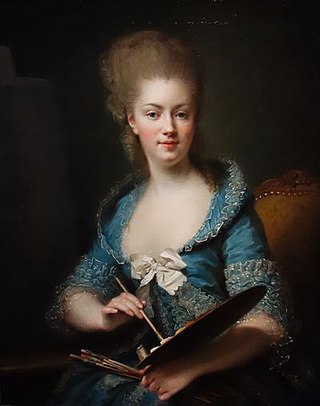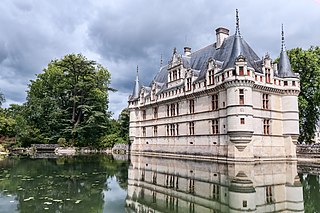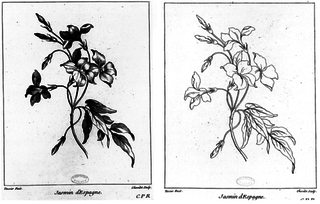
Jacques-Louis David was a French painter in the Neoclassical style, considered to be the preeminent painter of the era. In the 1780s, his cerebral brand of history painting marked a change in taste away from Rococo frivolity toward classical austerity, severity, and heightened feeling, which harmonized with the moral climate of the final years of the Ancien Régime.

Marie Antoinette was the last queen consort of France prior to the French Revolution. Marie Antoinette was the wife of Louis XVI. Born Archduchess Maria Antonia of Austria, she was the penultimate child and youngest daughter of Empress Maria Theresa and Emperor Francis I. She married Louis XVI, Dauphin of France, in May 1770 at age 14. She then became the Dauphine of France. On 10 May 1774, her husband ascended the throne as Louis XVI and she became queen.

The Château de Chenonceau is a French château spanning the river Cher, near the small village of Chenonceaux, Indre-et-Loire, Centre-Val de Loire. It is one of the best-known châteaux of the Loire Valley.

The Château de Chaumont, officially Château de Chaumont-sur-Loire, is a castle (château) in Chaumont-sur-Loire, Centre-Val de Loire, France. The castle was founded in the 10th century by Odo I, Count of Blois. After Pierre d'Amboise rebelled against Louis XI, the king ordered the castle's destruction. Later in the 15th century Château de Chaumont was rebuilt by Charles I d'Amboise. Protected as a monument historique since 1840, the château was given into state ownership in 1938 and is now open to the public.
Chaumont is a village in Jefferson County, New York, United States. Its population was 624 at the 2010 census. The village is named for Jacques-Donatien Le Ray de Chaumont, son of Benjamin Franklin's landlord and friend at Passy in France. The village of Chaumont is in the town of Lyme and is northwest of Watertown.

Honoré Gabriel Riqueti, Count of Mirabeau was a French writer, orator, statesman and a prominent figure of the early stages of the French Revolution.

Jacques Laffitte was a leading French banker, governor of the Bank of France (1814–1820) and liberal member of the Chamber of Deputies during the Bourbon Restoration and July Monarchy. He was an important figure in the development of new banking techniques during the early stages of industrialization in France. In politics, he played a decisive role during the Revolution of 1830 that brought Louis-Philippe, the duc d'Orléans, to the throne, replacing the unpopular Bourbon king Charles X.

Passy is an area of Paris, France, located in the 16th arrondissement, on the Right Bank. It is adjacent to Auteuil to the southwest, and Chaillot to the northeast.

French involvement in the American Revolutionary War of 1775–1783 began in 1776 when the Kingdom of France secretly shipped supplies to the Continental Army of the Thirteen Colonies when it was established in June 1775. France was a long-term historical rival with the Kingdom of Great Britain, from which the Colonies were attempting to separate.

William Temple Franklin Jr, known as Temple Franklin, was an American diplomat and real estate speculator who is best known for his involvement with the American diplomatic mission in France during the American Revolutionary War. Beginning at the age of 16, he served as secretary to his grandfather Benjamin Franklin, who negotiated and agreed to the Franco-American Alliance.

Joseph-Siffred Duplessis was a French painter known for the clarity and immediacy of his portraits.

Rosalie Filleul was a French pastellist and painter. She was born in Paris, and was concierge of the Château de la Muette. Although she initially supported the French Revolution, she nevertheless became disillusioned by its excesses and mourned the execution of Louis XVI. Somewhat indiscreetly, at the height of the Terror, she made arrangements to sell some of the furniture at the Château de la Muette to a secondhand dealer. This was reported to the authorities and she was arrested on charges of theft and concealment of biens nationaux – property belonging to the Republic. Rosalie Filleul was found guilty and guillotined in 1794, along with her friend Mme Chalgrin, despite the attempted intervention of Chalgrin's brother Carle Vernet.

LeRay(pronounced /’leh-ray/)Mansion is a National Register Listed Historic District located in Fort Drum, NY. The LeRay Mansion was originally built as the estate for James LeRay de Chaumont. James LeRay originally came to the North Country in order to regain his family’s fortune. Jacques Donatien LeRay de Chaumont, James LeRay’s father, was a French entrepreneur who loaned a considerable portion of his fortune to support the American Revolution. Jacques LeRay was the single largest financial supporter of the American Revolution from France, outspending the French Government. This earned Jacques LeRay the name French “Father of the American Revolution.” Jacques LeRay was a gracious host to members of the new Continental government at his estate in Passy, France. These guests included John Adams, Silas Deane, Arthur Lee, James Madison, and Benjamin Franklin, the latter of whom taught English to James LeRay.

The Château d'Azay-le-Rideau is located in the town of Azay-le-Rideau in the French département of Indre-et-Loire. Built between 1518 and 1527, this château is considered one of the foremost examples of early French renaissance architecture. Set on an island in the middle of the Indre river, this picturesque château has become one of the most popular of the châteaux of the Loire valley.

Juste Chevillet (1729–1802) was a French engraver. He is known for his engravings for the Histoire Naturelle of Georges-Louis Leclerc, Comte de Buffon.
Donatien is a masculine given name of French origin. People with that name include:

The Hôtel de Valentinois was an hôtel particulier, a kind of large townhouse of France, in Passy, bordering at its greatest extent present-day Rue Raynouard, present-day Rue des Vignes, Rue Bois-le-Vent, to present-day Rue de l'Annonciation.
The Pensionnat des Frères des écoles chrétiennes à Passy was a boarding school for boys located in the present-day 16th arrondissement of Paris and active between 1839 and 1905.

Neoclassicism is a movement in architecture, design and the arts which emerged in France in the 1740s and became dominant in France between about 1760 to 1830. It emerged as a reaction to the frivolity and excessive ornament of the baroque and rococo styles. In architecture it featured sobriety, straight lines, and forms, such as the pediment and colonnade, based on Ancient Greek and Roman models. In painting it featured heroism and sacrifice in the time of the ancient Romans and Greeks. It began late in the reign of Louis XV, became dominant under Louis XVI, and continued through the French Revolution, the French Directory, and the reign of Napoleon Bonaparte, and the Bourbon Restoration until 1830, when it was gradually replaced as the dominant style by romanticism and eclecticism.

Franklin is a 2024 biographical drama miniseries about the United States Founding Father Benjamin Franklin, based on Stacy Schiff's 2005 book A Great Improvisation: Franklin, France, and the Birth of America. It was released on Apple TV+ on April 12, 2024. The series depicts the eight years Benjamin Franklin spent in France to convince King Louis XVI to support the burgeoning United States in the American Revolutionary War.

















